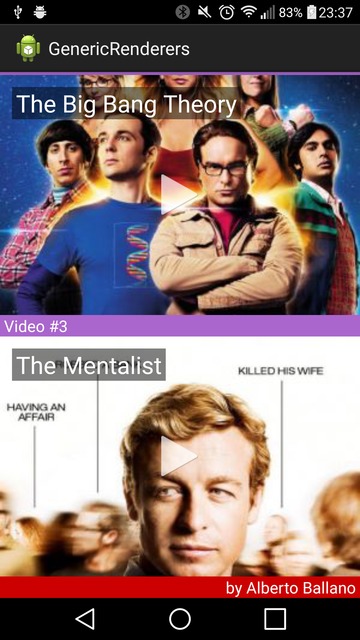GenericRenderers 





Based on Renderers lib made by pedrovgs
DIFFERENCE WITH RENDERERS
The main difference of this project is that is totally generic, which means:
- No need to wrap every model in another object.
- Possibility to bind more complex objects without extra effort.
But be aware that also means that you'll loose type safety.
USAGE
First of all, let's create as many Renderers as different views we need, for example:
public class VideoRenderer extends Renderer<Video> {
@Bind(R.id.iv_thumbnail)
ImageView thumbnail;
@Bind(R.id.tv_title)
TextView title;
/**
* Inflate the main layout used to render videos in the list view.
*
* @param inflater LayoutInflater service to inflate.
* @param parent ViewGroup used to inflate xml.
* @return view inflated.
*/
@Override
protected View inflate(LayoutInflater inflater, ViewGroup parent) {
View inflatedView = inflater.inflate(R.layout.video_renderer, parent, false);
/*
* You don't have to use ButterKnife library to implement the mapping between your layout
* and your widgets you can implement setUpView and hookListener methods declared in
* Renderer<T> class.
*/
ButterKnife.bind(this, inflatedView);
return inflatedView;
}
@OnClick(R.id.iv_thumbnail)
void onVideoClicked() {
Video video = getContent();
Toast.makeText(getContext(), "Video clicked. Title = " + video.getTitle(), Toast.LENGTH_LONG).show();
}
/**
* Main render algorithm based on render the video thumbnail, render the title, render the marker
* and the label.
*/
@Override
public void render(List<Object> payloads) {
Video video = getContent();
Picasso.with(getContext()).cancelRequest(thumbnail);
Picasso.with(getContext())
.load(video.getThumbnail())
.placeholder(R.drawable.placeholder)
.into(thumbnail);
title.setText(video.getTitle());
}
}
Now there are 3 possible usages:
Basic usage: only 1 model
RendererBuilder.create(new VideoRenderer())
.buildWith(videoCollection)
.into(recyclerView);
Advanced usage: multiple models
Ok, let's assume we now have another Renderer called SectionRenderer which is basically a section separator for our videos. Since is a simple header we just want to bind it with a String object, like:
RendererAdapter adapter = RendererBuilder.create()
.bind(Video.class, new VideoRenderer())
.bind(String.class, new SectionRenderer())
.build()
.into(recyclerView);
As you can see we use the default create method for the RendererBuilder and then use the chained bind methods to specify the renderer type for each item type we have.
Also, we don't provide our list in the constructor anymore (but we could), since we want to add the headers dynamically, like:
for (int i = 0, videoCollectionSize = videoCollection.size();
i < videoCollectionSize; i++) {
adapter.add("Video #" + (i + 1));
adapter.add(videoCollection.get(i));
}
As you can see there's no problem in adding different types since the list in the adapter will be of type Object. In case that you add a different type that doesn't have a Renderer associated with, an exception will be thrown.
More complex usage: multiple complex models
Ok, let's go for a bit more complex thing, let's imagine that now we want to add a single footer at the end of the list with the FooterRenderer that you can see in the example. The type will be again a String class, so we need to differentiate between the String associated with the SectionRenderer added in the previous example, like this:
RendererAdapter adapter = RendererBuilder.create()
.bind(Video.class, new VideoRenderer())
.bind(TYPE_FOOTER, new FooterRenderer())
.bind(TYPE_SECTION, new SectionRenderer2())
.build()
.into(recyclerView);
Where those types are plain integers. Finally we do the same as we did before and we add our footer at the end:
for (int i = 0, videoCollectionSize = videoCollection.size();
i < videoCollectionSize; i++) {
adapter.add(new RendererContent<>("Video #" + (i + 1), TYPE_SECTION));
adapter.add(videoCollection.get(i));
}
adapter.add(new RendererContent<>("by Alberto Ballano", TYPE_FOOTER));
As you see we need to add the wrapper now, since we need a generic object in which put the TYPE integer. But as you can see that's only for the objects that have to be mapped this way, so the Video class stays the same, no wrapper at all!
IMPORTANT: We also need to modify the SectionRenderer to use a different type:
public class SectionRenderer extends Renderer<RendererContent<String>>EXTRA: Note that binding generic classes is also possible:
Assuming that we have many different Video implementations extending from BaseVideo but we want to map all of them to the same renderer we could just do:
RendererBuilder rendererBuilder = new RendererBuilder()
.bind(BaseVideo.class, new VideoRenderer())
.bind(String.class, new SectionRenderer());
And therefore all BaseVideo subclasses added to the adapter will be mapped to the VideoRenderer. For obvious reasons bindings to Object.class are forbidden to avoid unexpected errors, for that case please check the first usage above.
INCLUDING IN YOUR PROJECT
With gradle: edit your build.gradle
allprojects {
repositories {
...
maven {
url "https://jitpack.io"
}
}
}
dependencies {
compile 'com.github.aballano:GenericRenderers:x.x.x'
}
Or declare it into your pom.xml
<repositories>
<repository>
<id>jitpack.io</id>
<url>https://jitpack.io</url>
</repository> </repositories> <dependency>
<groupId>com.github.aballano</groupId>
<artifactId>GenericRenderers</artifactId>
<version>x.x.x</version> </dependency>

